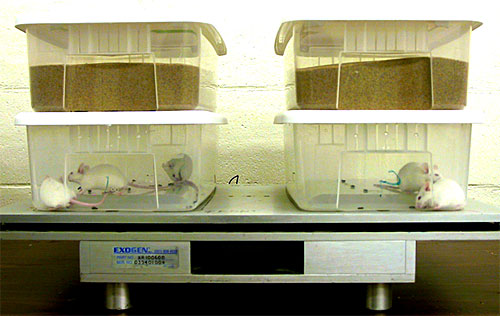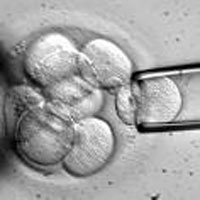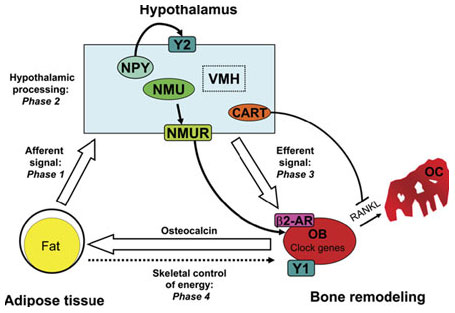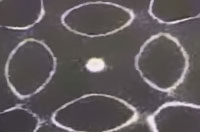| |
Sixty percent of adult Americans are overweight. One of the best ways to decrease obesity is to increase exercise. Exercise helps you burn more Calories and regulates metabolism by controlling the amount of fatty acids and sugar in the blood. There has been a trend that says the more strenuous the exercise, the greater the impact on the body. Or, in short, the more exercise, the better.
But Dr. Clifford Rosen of the Maine Medical Center Research Institute, in collaboration with Dr. Clinton Rubin of Stony Brook University, has been studying the effects of short periods of low impact exercise on the body, including bone and muscle. Dr. Rosen simulated this exercise in animals by putting mice on a vibrating platform developed by Dr. Clinton Rubin:

The Rubin Machine (The container on top of each cage is a weight that keeps
it from vibrating off the table.)
Because fat cells (Adipocytes) and bone cells come from the same original type of cell,
Dr. Rosen and his collaborators hypothesized that this low level of exercise would suppress the differentiation of stem cells into adipocytes. In other words, the vibration would slow down or prevent the basic stem cells from becoming fat cells – instead they would become bone cells.
 |
 |
What are stem cells?
Stem cells are vital to scientific research because they can become many different kinds of cells. You may have heard of embryonic stem cells, as their use in scientific research has become controversial. Embryonic stem cells are the cells found in the developing fetus. They will differentiate; that is, they will become brain cells, muscle cells, bone cells, fat cells, or any other type of cell; as embryonic stem cells they have limitless potential. |
Embryonic stem cells are optimal for research because researchers can make them into any type of cell they need. Adults, too, have stem cells imbedded among already differentiated cells. Adult stem cells are more limited in what they can become, but they are a critical part of adult bodies. When cells die, stem cells are able to take their place.
Whatís the connection with Dr. Rosenís work?
To do these experiments, Dr. Rosen and his team used two groups of mice: one group was put on a vibrating platform every day for 15 weeks, and the other group was not. Each animalís food and water consumption and body weight were measured daily. After 12 weeks, the researchers measured the amount of fat (lean body mass) in each animal. At the end of the research, the investigators studied tissue samples to compare the composition of cells in the exercised group and the control group. The results show the exercised group, even with this low impact kind of exercise, had fewer fat cells and produced less fat than the animals that were no exercised.
Dr. Rosen also showed that exercised animals had increased bone density compared to the control group. Dr. Rosen had noticed that the mice with increased bone density also had reduced body fat and triglycerides. This led him to another research project to look at the connection between fat cells and bone cells.
To do this, he transplanted bone cells attached to fluorescent proteins into mice. Half the mice were exercised for six weeks, and half the mice were in the control group. By following the fluorescent protein, Dr. Rosen and his collaborators determined that exercise inhibited stem cells from forming fat cells. Instead, these cells formed new bone cells.
The body is continually making new bone, a process called bone remodeling. This process is regulated by the nervous system, through circulating hormones and it is believed to have 4 phases, as shown in the figure below:

In Phase 1, fat cells relay the bodyís fuel status to the part of the brain called the hypothalamus. The hypothalamus, through the nervous system, sends signals to bone cells. Bone cells sense the bodyís energy status and stimulate the production of fat cells. In this way, the nervous system regulates the energy utilization and the production of bones.
Stem cells can become either fat cells or bone cells. The vibration of the mice changed the “fate” of the stem cells. Instead of fat cells, they became bone cells.
Medical Uses?
A technology such as the vibrating platform used for mice could have dual applications in humans. First, it could be used to increase the bone density of elderly people to reduce their susceptibility to broken bones. Second, it could be used to increase weight loss in overweight people. Current studies have shown that people who exercise more are thinner and have a faster metabolism.
Strong bones are an important part of leading a healthy life. It is the reason your parents tell you to drink milk; loss of bone density and bone strength is also why the bones of elderly people break much more readily than those of younger people. In a country with increasing rates of obesity and a growing number of old people, this research has the potential to greatly improve the quality of our health and lives.
Dr. Clifford Rosen is a Senior Scientist at Maine Medical Center’s Research Institute and a Professor of Nutrition at the University of Maine in Orono, Maine. He also works as a Senior Staff Scientist at the Jackson Laboratory in Bar Harbor, Maine. |
|

Dr. Clifford Rosen
 Salt on a Vibrating Table Salt on a Vibrating Table

Vibrating tables serve dozens of engineering, educational, and industrial purposes, as well as mouse research. Here is one you may have seen in Physics class.
Sign Up for our Monthly Announcement!
...or  subscribe to all of our stories! subscribe to all of our stories!

What A Year! is a project of the Massachusetts
Society for Medical Research.
|
|

